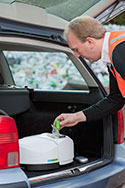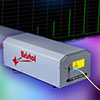


|
FTS is broadening as new techniques appear and commercial instrumentation becomes more sophisticated. Applications are evolving to include astronomy and planetary science, atmospheric and environmental remote sensing, pharmaceutical research and quality control, and all types of chemical and molecular laboratory spectroscopy.
|
|
|
|

|



|
Improvements to Förster resonance energy transfer would not only make it easier to use in existing applications, but also open it up to novel applications such as single-molecule analysis inside living cells.
|
|
|
|



|
USB Spectrometers
Ocean Optics
Ocean Optics USB series spectrometers are versatile spectrometers for UV, Visible and Shortwave NIR (200-1100nm) applications.
More info >>
|
|

|

|
Laser Spectrum Analyzer
Bristol Instruments
The 721 Series operates as a high-accuracy wavelength meter and a high-resolution spectrum analyzer for spectral characterization of CW and high-repetition rate pulsed lasers.
More info >>
|
|

|
|
|

|
|



|
The Multi-Unit Spectroscopic Explorer uses 24 spectrographs to create images and spectra of selected regions of the sky. This allows for the study of the properties of an object at different wavelengths, analyzing chemical composition and other physical properties, simultaneously.
|
|
|
|

3 Questions Interview: Prof. Dr. Jürgen Popp
"We are planning to transfer our Raman approaches into clinical settings [and focus] on in vivo Raman spectroscopy to monitor pathophysiological processes within organs. These efforts involve the development of portable and easy-to-use inclusive laser and Raman systems."
|
|
|
|

Studying Altitude Sickness with NIR Spectroscopy
Using NIR spectroscopy, researchers from University Hospital Frankfurt monitored changes in concentration of hemoglobin, both oxygenated and deoxygenated, in the supply of blood to mountain climbers' brains to determine whether abnormal breathing patterns were reducing that supply and potentially exacerbating the effects of altitude sickness.
|
|
|
|

Webinar: Light Advances in Biomedicine
In one of our most popular webinars to date, Dr. Robert R. Alfano, distinguished professor of science and engineering at The City College of the City University of New York, discusses key fingerprints to detect aggressive cancer cells; two new NIR spectral windows for imaging with less scattering of light in tissue; the use of upper singlet S2 for dyes to increase imaging depth using two-photon techniques; the use of spatial frequency spectra to detect structure in cancerous tissues and the brain; and, most of all, the use of supercontinuum – the ultimate white light – in biomedicine applications. Watch the archived video of his presentation here.
|
|


|
|
sponsor
 |

sponsor
 |

sponsor
 |

sponsor
 |

sponsor
 |


|